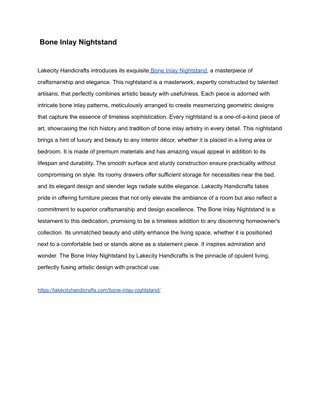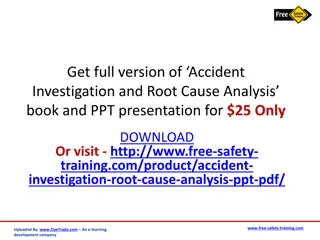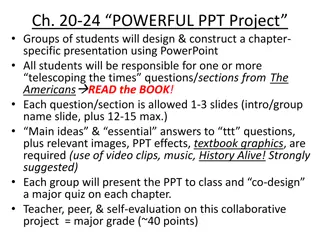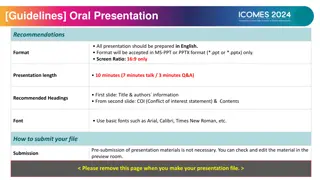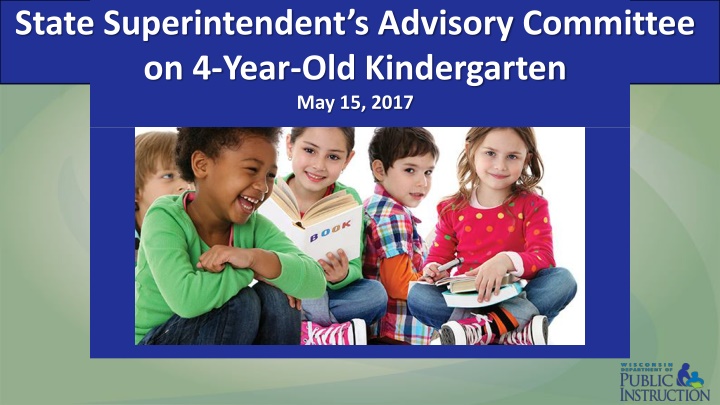
Insights into Wisconsin's 4-Year-Old Kindergarten Programs
Explore the State Superintendent's Advisory Committee on 4-Year-Old Kindergarten in Wisconsin, including enrollment statistics, community approaches, and student participation rates. Discover the growth and impact of 4K programs, with a focus on serving age-eligible children across the state.
Download Presentation

Please find below an Image/Link to download the presentation.
The content on the website is provided AS IS for your information and personal use only. It may not be sold, licensed, or shared on other websites without obtaining consent from the author. If you encounter any issues during the download, it is possible that the publisher has removed the file from their server.
You are allowed to download the files provided on this website for personal or commercial use, subject to the condition that they are used lawfully. All files are the property of their respective owners.
The content on the website is provided AS IS for your information and personal use only. It may not be sold, licensed, or shared on other websites without obtaining consent from the author.
E N D
Presentation Transcript
State Superintendents Advisory Committee on 4-Year-Old Kindergarten May 15, 2017 FIND PICTURE!
Whats New in 2016-17? Serving 48,764 Students Up from 48,109 from last year Estimated to be more than 75% of Wisconsin s age- eligible children. 397 4K programs 3 New this year 3 more anticipated for 2017-18 122 using Community Approaches 2
4K Opportunities 4K Opportunities by County Major Takeaways: 97% of Wisconsin s children reside in a district offering 4K. More than half of those children reside in districts utilizing a 4K Community Approach (4KCA). 2007-2008 2016-2017 47 46 Latitude 45 44 43 -92 -90 -88 -92 -90 -88 Longitude Legend [0,20] (20,40] (40,60] (60,80] (80,100] 3
4K Opportunities The 4K Community Approach (4KCA) is used in less than half of districts. 4K Opportunities by District 100% 10 14 27 33 37 4K Unavailabl e 48 64 80 90% 99 80% School- Based 4K 70% 281 286 60% 282 288 271 255 Percent 245 236 50% 238 40% 30% 20% School & Comm. 95 82 70 83 73 74 71 72 55 10% 34 32 32 31 30 27 26 Comm. 25 23 0% 2008-09 2009-10 2010-11 2011-12 2012-13 YEAR 2013-14 2014-15 2015-16 2016-17 4
4K Opportunities 4K Opportunities by Student The districts that use the Community Approach tend to be more populous. 100% 3.2 4.2 6.7 7.7 11.4 13.7 90% 21.3 24.4 29.2 No 4K 80% 33.8 33.1 38.1 29.3 42 70% 40.5 28.3 27.2 School- Based 4K 60% Percent 30.5 50% 40% 51.7 53.3 47.7 44.5 38.7 30% 41.1 36.8 40.4 29 School & Community 20% 10% 11.5 11.3 11.2 10.9 10.7 Comm. 9.6 9.4 9.3 8.1 0% 2008-09 * These numbers are estimates based on 5K population 2009-10 2010-11 2011-12 2012-13 School Year 2013-14 2014-15 2015-16 2016-17 5
4K Enrollment 4K Participation by County Major Takeaways: Enrollment in public school in 4K is normalizing across the state. Demographically, 4K and 5K students look identical. 2007-2008 2016-2017 47 46 Latitude 45 44 43 -92 -90 -88 -92 -90 -88 * These maps represent the percentage of 5K students by county who first enrolled in 4K. Longitude Legend [0,20] (20,40] (40,60] (60,80] (80,100] 6
4K Enrollment Participation in State-Funded 4K Nearly 80% of Wisconsin children enter public school in 4K. 90 78.5 76.8 5K Only 75.6 80 71.2 71.2 67.6 65.6 70 62 59.7 57.2 60 50.3 PERCENTAGE 50 42.8 49.7 40.3 38 40 34.4 32.4 28.8 28.8 30 24.4 23.2 21.5 4K & 5K 20 10 0 2007-08 2008-09 2009-10 2010-11 2011-12 2012-13 2013-14 2014-15 2015-16 2016-17 2017-18 1ST GRADE COHORT 7
4K Enrollment 4K Enrollment has been demographically stable since 2010. More racially diverse than Census estimates would suggest. 4K Participation is consistent with 5K enrollments. 2016-17 4K Enrollments by Race 90 2015 Census Estimates 80 70 60 PERCENT 50 40 30 20 10 0 Asian Black Hispanic American Indian RACE / ETHNICITY Pacific Isle Two or More White 8
4KEnrollment 4K Enrollment by Economic Status Participation in 4K isn t lower among economically disadvantaged students, they just are not identified as FRL eligible until the following year. Adjusted FRL status leads FRL status by 1 year where available. 60 49.4 49.2 48.4 47.7 50 46.9 46.8 46 45.5 44.7 43.7 42.4 42 40.7 40.3 38.9 38.2 40 36.5 35.9 35.3 35 34.1 PERCENT FRL 33.4 30 20 FRL as Reported Adjusted FRL 10 0 2005-06 2006-07 2007-08 2008-09 2009-10 2010-11 2011-12 2012-13 2013-14 2014-15 2015-16 SCHOOL YEAR 9
4KEnrollment Economically Disadvantaged Enrollments In the past, economically disadvantaged students enrolled in 4K at higher rate than their peers. This trend has since equalized. 51 49.4 49.2 48.4 49 47.7 4K Adj. FRL 48.7 46.9 46.8 48 47.9 47 46 45.5 44.7 45.9 44.5 45.9 45 PERCENT FRL 43.7 43 43 42.4 42.3 41 39.2 5K FRL 39 38.1 37.4 * Unless otherwise noted, all subsequent slides referencing economic status use the Adjusted FRL indicator. 37 35 2007-08 2008-09 2009-10 2010-11 2011-12 2012-13 2013-14 2014-15 2015-16 2016-17 2017-18 1ST GRADE COHORT 10
4KEnrollment 4K Participation of Students with Disabilities Students with disabilities are identified and enroll in 4K at the same rate as 5K. 14 13 PERCENT DISABLED 12 11 10 9 4K 5K 8 2005-06 2006-07 2007-08 2008-09 2009-10 2010-11 2011-12 2012-13 2013-14 2014-15 2015-16 2016-17 SCHOOL YEAR 11
4KEnrollment Participation in 4K is fairly consistent across district poverty rates 5K Only 4K & 5K 12
4K Attendance 4K Habitual Truancy by County Major Takeaways: 4K students attend school more consistently than students in subsequent grades. Habitual truancy is most common among historically marginalized populations. 2006-2007 2015-2016 47 46 Latitude 45 44 43 -92 -90 -88 -92 -90 -88 Longitude [0,15] (15,30] (30,45] (45,60] (60,75] NA Legend 13
4K Attendance 4K Students are consistently less likely to be habitually truant (absent >= 10 days per school year) than their 5K peers. Early Childhood Habitual Truancy Rates 40 35.7 5K Truancy 34.9 33.6 33.4 35 32.3 32.1 31.7 31.6 31.4 31.2 30.9 30 27.1 29.9 26.1 25.9 24.8 24.6 PERCENT TRUANT 23.8 23.3 23.3 25 22.9 4K Truancy 20.7 20 15 10 5 0 2005-06 2006-07 2007-08 2008-09 2009-10 2010-11 2011-12 2012-13 2013-14 2014-15 2015-16 SCHOOL YEAR 14
4K Attendance Absenteeism most commonly affects students of color. This correlates heavily with economic status. Habitual Truancy Rates by Race (2015-16) 60 50.2 50 40.4 39.3 40 PERCENT TRUANT 35.1 28.8 30 27.1 22.9 Mean 20 15.9 10 0 Asian Black Hispanic American Indian RACE Pacific Isle Two or More White 15
4K Attendance Chronic absenteeism is most common among economically disadvantaged students Habitual Truancy Rates by Economic Status 45 42.3 40.1 39 40 36.4 36 34.8 Economically Disadvantaged 34.5 34.1 34.1 33.6 35 30.4 30 PERCENT TRUANT 25 19.5 20 17 16.5 15.9 15.2 14.9 14.3 14 13.5 13.3 15 11.6 Not Economically Disadvantaged 10 5 0 2005-06 2006-07 2007-08 2008-09 2009-10 2010-11 2011-12 2012-13 2013-14 2014-15 2015-16 SCHOOL YEAR 16
4K Attendance Students with disabilities are more frequently truant than their non-disabled peers. Habitual Truancy by Disability Status 40 37.8 Students with Disabilities 35 31.3 31.2 31 30.2 29.5 28.9 28.8 28.8 28.7 30 27.3 26.4 26.1 25.3 25 24 PERCENT TRUANT 23.6 25 22.9 22.4 22.4 22.2 19.9 Students without Disabilities 20 15 10 5 0 2005-06 2006-07 2007-08 2008-09 2009-10 2010-11 2011-12 2012-13 2013-14 2014-15 2015-16 SCHOOL YEAR 17
4K Attendance Districts with large economically disadvantaged populations tend to experience the largest truancy problems. * Blue points represents districts with a majority of students with races / ethnicities other than white 18
4K Suspensions 4K Suspensions by County Major Takeaways: A lot of progress has been made to decrease early childhood suspensions. Wisconsin s EC suspension rates remain higher than the national average. 2006-2007 2015-2016 47 46 Latitude 45 44 43 -92 -90 -88 -92 -90 -88 Longitude [0,0.5] (0.5,1] (1,1.5] (1.5,2] (2,2.5] NA Legend 19
4K Suspensions Early Childhood Suspensions are on the decline. Early Childhood Suspensions by Grade 1.6 5 Year Old Kindergarten 1.47 1.36 1.34 1.4 1.32 1.31 1.26 1.24 1.17 1.13 1.2 1.08 PERCENT SUSPENDED 1 0.76 0.8 0.66 0.65 0.59 0.53 0.6 0.46 0.44 4 Year Old Kindergarten 0.33 0.4 0.27 0.16 0.2 0 2006-07 2007-08 2008-09 2009-10 2010-11 SCHOOL YEAR 2011-12 2012-13 2013-14 2014-15 2015-16 20
4K Suspensions Top Contributors to Declining EC Suspensions Milwaukee and Madison are top contributors *Calculated by multiplying change in suspension rates with student population 2 1.8 1.82 1.6 1.4 PERCENT SUSPENDED 1.2 1.21 1.06 4K & 5K Combined State Average 1 0.96 0.79 0.8 0.74 0.8 0.63 0.53 0.6 0.51 0.62 0.44 Milwaukee most improved district *Greatest decrease in suspension rate since 2011 among districts with a minimum combined 4K and 5K cohort of 100 students Milwaukee 0.4 Madison 0.2 0.26 0.02 0.02 0 2011-12 2012-13 2013-14 SCHOOL YEAR 2014-15 2015-16 21
4K Suspensions 4K Suspensions by Race Black students continue to be the most affected by Early Childhood suspensions. These rates far exceed most estimations of the national average. 4.28 4.5 3.83 3.79 4 3.42 3.5 3.25 Black 2.95 PERCENT SUSPENDED 2.81 3 2.5 2.11 1.89 2 1.5 1.13 1 Hispanic 0.7 0.58 0.53 0.5 0.33 0.08 0.37 0.32 0.07 0.3 0.07 0.26 0.07 0.19 0.04 0.08 0.05 2015-16 0.14 0.12 0.07 0.05 White 0 2006-07 2007-08 2008-09 2009-10 2010-11 SCHOOL YEAR 2011-12 2012-13 2013-14 2014-15 22
4K Suspensions Black and Hispanic students also receive longer suspensions on average. Average Suspension Length by Race 1.8 1.58 1.6 1.36 1.4 1.17 1.2 DAYS SUSPENDED 1 0.8 0.6 0.4 0.2 0 Black Hispanic White RACE / ETHNICITY 23
4K Suspensions Suspensions among males consistently outnumber females at a rate of 4:1. 4K Suspensions by Gender 1.4 1.15 1.2 Male 0.96 0.95 1 PERCENT SUSPENDED 0.88 0.8 0.8 0.68 0.68 0.6 0.49 0.37 0.34 0.34 0.4 0.33 0.27 0.26 0.23 0.21 0.18 0.17 Female 0.16 0.2 0.06 0 2006-07 2007-08 2008-09 2009-10 2010-11 SCHOOL YEAR 2011-12 2012-13 2013-14 2014-15 2015-16 24
4K Suspensions Suspensions among students with disabilities are on the decline. 4K Suspensions by Disability Status 1.6 1.46 1.44 1.38 1.4 Students with Disabilities 1.2 1.08 1.03 PERCENT SUSPENDED 1 0.89 0.8 0.72 0.7 0.67 0.53 0.53 0.6 0.52 0.44 0.4 0.39 0.39 Students without Disabilities 0.4 0.29 * Note: because suspensions can lead to the implementation of IEPs for Emotional and Behavioral challenges, there is some endogeneity to these indicators. 0.28 0.25 0.14 0.2 0 2006-07 2007-08 2008-09 2009-10 2010-11 SCHOOL YEAR 2011-12 2012-13 2013-14 2014-15 2015-16 25
4K Suspensions Suspensions among economically disadvantaged students are also on the decline. Suspensions by Economic Status 1.8 1.55 1.6 1.36 1.32 1.4 Economically Disadvantaged 1.15 PERCENT SUSPENDED 1.2 1.03 1 0.87 0.8 0.8 0.58 0.6 0.5 Not Economically Disadvantaged 0.32 0.4 0.15 0.2 0.11 0.1 0.09 0.08 0.07 0.07 0.06 0.05 0.04 0 2006-07 2007-08 2008-09 2009-10 2010-11 SCHOOL YEAR 2011-12 2012-13 2013-14 2014-15 2015-16 26
4K Suspensions Districts with large populations of economically disadvantaged students tend to have the highest suspension rates. These districts efforts are to thank for the state-wide decline. * Blue points represent districts with a majority of students with races / ethnicities other than white. 27
4K Retention 4K Retention by County Major Takeaways: 4K Retention (enrolling in 4K for two consecutive years) continues to be a problem. It is disproportionately extended to white students Retention among students with disabilities is on the decline. 2007-2008 2016-2017 47 46 Latitude 45 44 43 -92 -90 -88 -92 -90 -88 Longitude [0,4] (4,8] (8,12] (12,16] (16,20] NA Legend 28
4K Retention Retention in 5K has fallen as enrollment in 4K increased. Too early to say if 4K retentions are on the decline. Early Childhood Retentions by Grade 3 5 Year Old Kindergarten 2.39 2.5 2.27 2.24 2.17 2.16 2.12 2 1.85 PERCENT RETAINED 1.74 1.99 1.99 1.61 1.83 1.84 1.77 1.51 1.62 1.37 1.5 4 Year Old Kindergarten 1.56 1.58 1.32 1.26 1 1.04 0.5 0 2006-07 2007-08 2008-09 2009-10 2010-11 2011-12 2012-13 2013-14 2014-15 2015-16 2016-17 SCHOOL YEAR 29
4K Retention White students are much more likely to spend multiple years in 4K. 4K Retention by Race 3 2.51 2.5 2.27 2.25 2.21 2.12 2.08 2.06 1.99 1.88 1.87 2 PERCENT RETAINED White 1.76 1.65 1.44 1.43 1.5 1.28 1.1 1.05 1.03 1.01 1 0.82 Other Races 0.78 0.73 0.5 0 2006-07 2007-08 2008-09 2009-10 2010-11 2011-12 2012-13 2013-14 2014-15 2015-16 2016-17 SCHOOL YEAR 30
4K Retention 4K retentions among students with disabilities are at an all-time low. 4K Retentions by Disability Status 9 7.82 8 6.73 Students with Disabilities 7 6.44 6.06 5.66 5.59 6 PERCENT RETAINED 5.49 5.02 4.98 5 4.04 3.83 4 3 Students without Disabilities 2 1.4 1.34 1.3 1.29 1.21 1.2 1.16 1.15 1.13 1.11 0.97 1 0 2006-07 2007-08 2008-09 2009-10 2010-11 2011-12 2012-13 2013-14 2014-15 2015-16 2016-17 SCHOOL YEAR 31
4K Retention There is no clear relationship between economic status and early childhood retentions 4K Retention by Economic Status 2.5 Economically Disadvantaged 2.29 2.24 2.04 2.01 1.91 2 2.05 1.99 1.79 1.88 1.67 1.72 1.64 1.62 1.77 1.73 PERCENT RETAINED 1.7 1.68 1.5 1.58 1.38 1.36 1.52 Not Economically Disadvantaged 1.28 1 0.5 0 2006-07 2007-08 2008-09 2009-10 2010-11 2011-12 2012-13 2013-14 2014-15 2015-16 2016-17 SCHOOL YEAR 32
4K Retention Small districts with predominantly white student populations are the most likely to allow a child to repeat 4K. Majority White Majority Other Races 33
References R Core Team (2017). R: A language and environment for statistical computing. R Foundation for Statistical Computing, Vienna, Austria. Version 3.3.3. URL: www.R- project.org. United States Census Bureau (2010). Wisconsin Quick Facts, Race and Hispanic Origin. URL: https://www.census.gov/quickfacts/table/PST045215/55,00. Wickham, Hadley & Winston Chang. (2009). ggplot2: Elegant Graphics for Data Analysis. Springer-Verlag New York. Version 2.2.1. URL: https://cran.r- project.org/web/packages/ggplot2/index.html Wisconsin Department of Public Instruction (2017). Wisconsin Information System for Education (WISEdash) Database. URL: https://dpi.wi.gov/wisedash. 34







